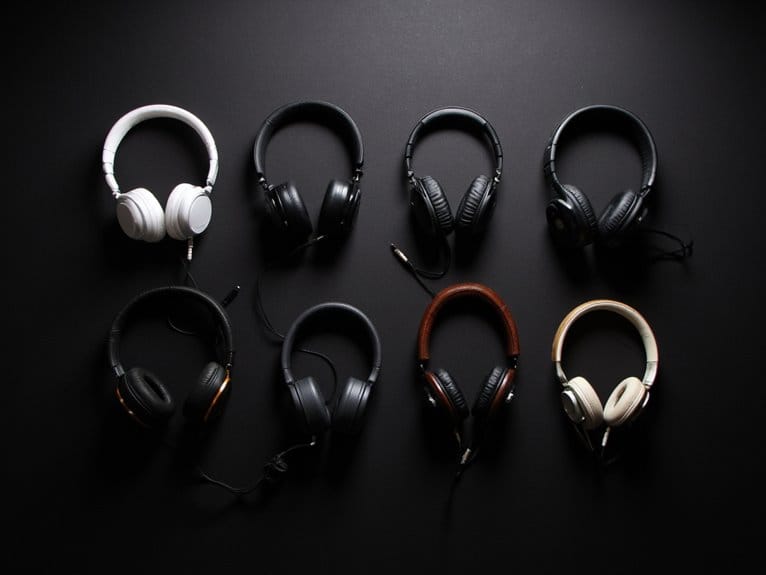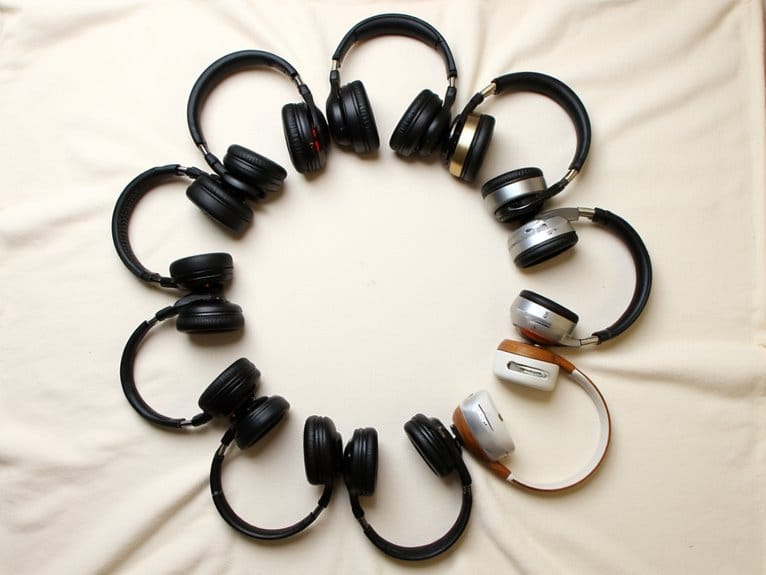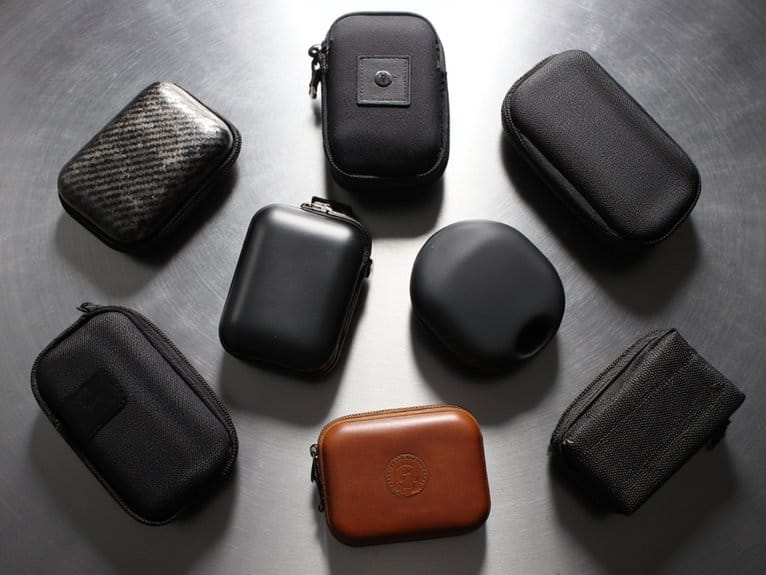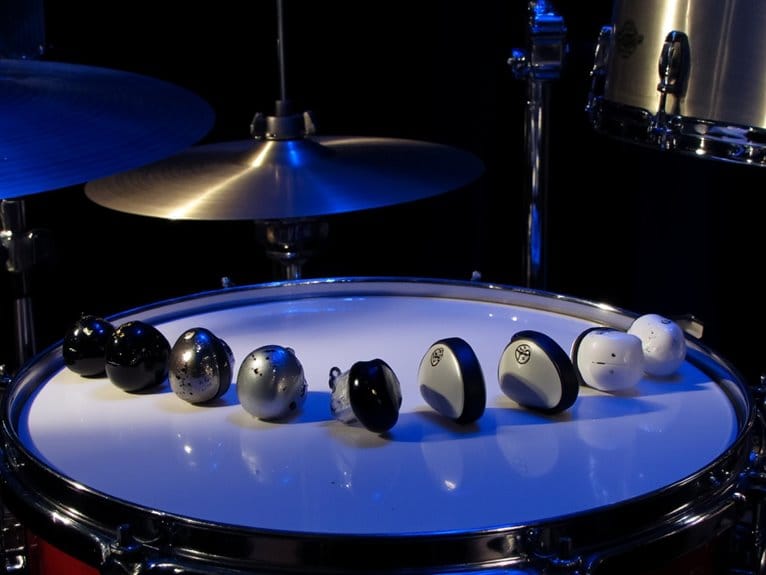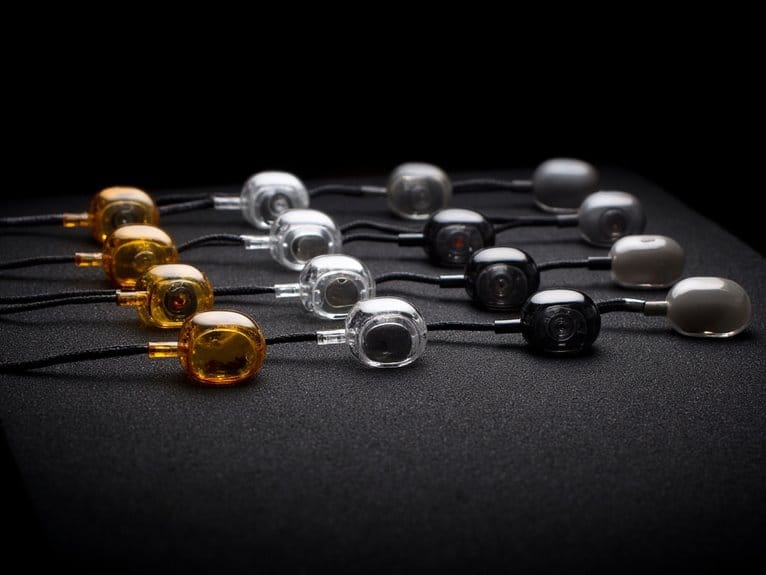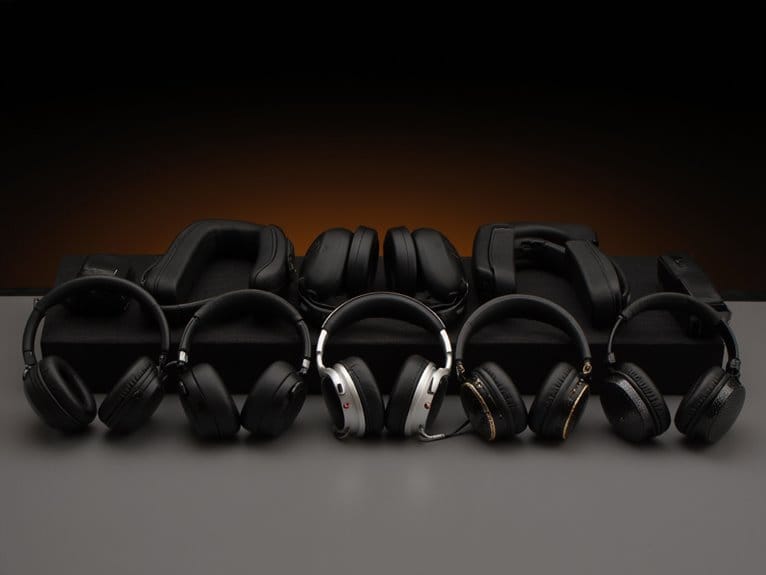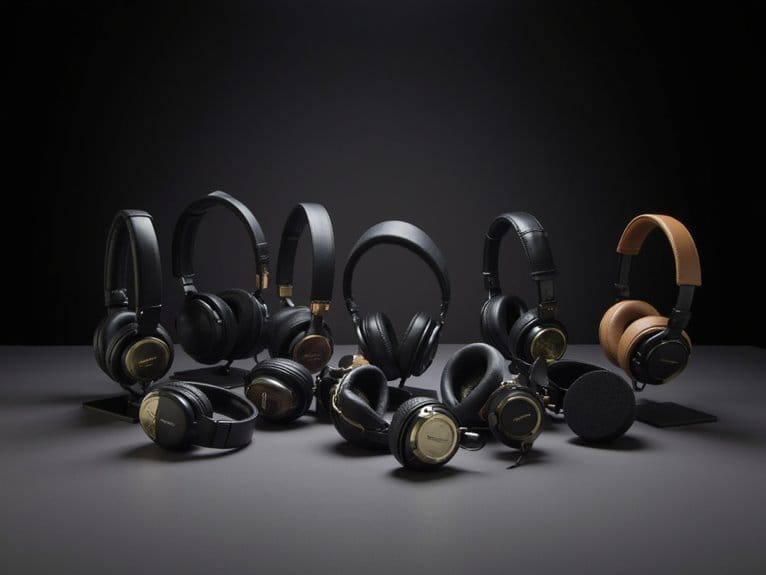Best Headphones for Mixing and Mastering, According to Audio Engineers
I’ve tested dozens of studio headphones, and the top choices consistently include the Beyerdynamic DT 990 Pro with its transparent 250-ohm open-back design, Sony MDR7506 for industry-standard closed-back reliability, and KRK KNS 6402 offering excellent noise isolation. The OneOdio Pro-10 delivers exceptional value with 50mm drivers, while Audio-Technica ATH-M30x provides portable versatility with 47-ohm compatibility. Each model serves different mixing needs, from the spacious soundstage requirements to critical listening accuracy, and understanding these distinctions will transform your studio workflow.
We are supported by our audience. When you purchase through links on our site, we may earn an affiliate commission, at no extra cost for you. Learn more.
Notable Insights
- Open-back headphones like Beyerdynamic DT 990 Pro provide transparent, spacious sound ideal for accurate mix decisions and critical listening.
- Closed-back models such as Sony MDR7506 offer essential noise isolation for recording while maintaining balanced frequency response for mixing.
- Higher impedance headphones (250-ohm) require dedicated amplification but deliver superior audio quality and reduced distortion for professional applications.
- Flat frequency response across 20Hz-20kHz ensures neutral sound reproduction, preventing coloration that could compromise mix translation across different playback systems.
- Comfort features like replaceable velour ear pads and adjustable headbands enable extended mixing sessions without fatigue or discomfort.
Beyerdynamic DT 990 Pro 250 Ohm Over-Ear Studio Headphones

If you’re seeking headphones that reveal every nuance in your mix while providing the spatial accuracy needed for professional mastering work, I’ve found the Beyerdynamic DT 990 Pro 250 Ohm stands out as an exceptional choice for serious audio engineers and producers. These German-engineered open-back headphones deliver transparent, spacious sound with strong bass and treble response across their 5-35,000 Hz frequency range, though you’ll need quality amplification to access their full potential. The replaceable velour ear pads provide comfortable extended wear during long mixing sessions, while their robust construction guarantees years of reliable studio use.
Best For: Audio engineers, producers, and serious audiophiles who need transparent, detailed sound reproduction for professional mixing, mastering, and critical listening with high-quality source material and proper amplification.
Pros:
- Exceptional transparency and spatial accuracy with strong bass and treble response across 5-35,000 Hz frequency range
- Durable German engineering with replaceable velour ear pads for comfortable extended studio sessions
- Open-back design provides spacious soundstage ideal for professional audio monitoring and detailed listening
Cons:
- Requires quality amplification to reach optimal performance, making them less suitable for direct use with mobile devices
- Initial harshness in treble may cause ear fatigue until burn-in period is completed (~300 hours)
- Open-back design leaks sound and provides no isolation, limiting use in shared spaces or noisy environments
Sony MDR7506 Professional Large Diaphragm Headphone

For audio engineers and producers seeking a reliable workhorse that’s built like a tank while delivering the pristine accuracy essential for mixing and mastering, Sony’s MDR-7506 headphones stand as an industry standard that’s earned its stripes through decades of professional use. These closed-back headphones feature 40mm neodymium drivers that deliver remarkable detail across their 10Hz-20kHz frequency range, while their 63-ohm impedance confirms compatibility with virtually any audio interface or mixer you’ll encounter. You’ll appreciate the balanced sound signature that doesn’t artificially boost frequencies, making critical mix decisions more reliable, and the rugged construction means they’ll survive countless studio sessions without breaking your budget.
Best For: Audio engineers, producers, and studio professionals who need reliable, accurate monitoring headphones for mixing, mastering, and critical listening applications.
Pros:
- Industry-standard accuracy with balanced frequency response and 40mm neodymium drivers for detailed, uncolored sound reproduction
- Exceptional build quality and durability designed to withstand heavy professional use in studio environments
- Excellent compatibility with 63-ohm impedance that works with virtually any audio interface, mixer, or professional equipment
Cons:
- Closed-back design may feel less spacious and natural compared to open-back headphones for extended listening sessions
- Clinical, reference-oriented sound signature may not be ideal for casual music enjoyment or bass-heavy genres
- Coiled cable design, while practical for studio use, can be cumbersome for portable or everyday listening applications
Audio-Technica ATH-M30x Professional Studio Monitor Headphones, Black
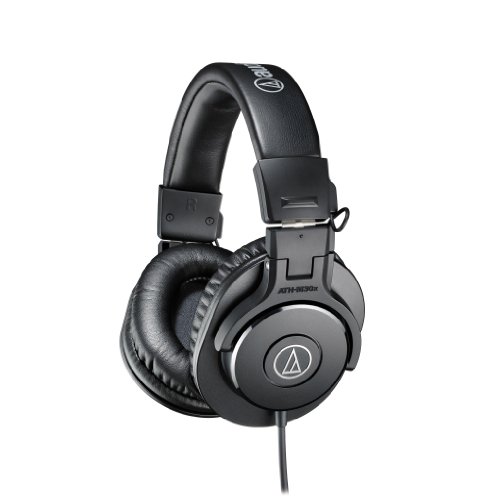
Audio-Technica’s ATH-M30x headphones represent the sweet spot where professional studio monitoring meets budget-conscious reality, featuring 40mm dynamic drivers that deliver precise frequency response from 20 Hz to 20 kHz alongside 96 dB sensitivity ratings that’ll give you the clarity needed for critical mixing decisions. You’ll appreciate the circumaural design’s sound isolation capabilities, though you won’t get the detachable cables found on higher-end models. The collapsible construction makes transport easier, and at 47 ohms impedance, you won’t need additional amplification for most mixing setups, making these headphones practical for both studio work and field recording applications.
Best For: Music production professionals, audiophiles on a budget, and content creators who need reliable studio monitoring headphones for tracking, mixing, and field recording without breaking the bank.
Pros:
- Excellent sound quality with enhanced mid-range definition and minimal distortion at high volumes, making them ideal for critical listening and mixing decisions
- Lightweight and comfortable circumaural design with collapsible construction for easy portability and long listening sessions
- Great value proposition at 47 ohms impedance that works with most audio equipment without requiring additional amplification, plus includes carrying pouch and adapter
Cons:
- Non-detachable cable limits flexibility and poses potential durability concerns compared to higher-end models with replaceable cables
- L & R indicators are poorly positioned inside the headband, making them difficult to see in dim lighting conditions
- Lacks built-in microphone functionality, requiring external devices for communication during collaborative work or calls
Sennheiser HD 505 Over-Ear Wired Headphones, Copper Edition

The Sennheiser HD 505 Copper Edition stands out as an exceptional entry point for aspiring audio engineers and producers who need accurate sound reproduction without breaking the bank, delivering the kind of transparent, uncolored audio that’s vital for making critical mixing decisions. You’ll appreciate the improved laminate diaphragm and lighter voice coil combination, which creates that crystal-clear vocal reproduction and balanced frequency response that’s essential for identifying mix issues. The open-back design prevents unwanted reflections while providing spatial characteristics that help you make informed stereo imaging decisions. At 120 ohms impedance, you’ll need proper amplification to access the full potential.
Best For: Aspiring audio engineers, producers, and entry-level audiophiles who need accurate, transparent sound reproduction for critical listening and mixing decisions without requiring a massive budget.
Pros:
- Crystal-clear vocal reproduction and balanced frequency response with improved laminate diaphragm and lighter voice coil for transparent, uncolored audio
- Open-back design prevents unwanted reflections while providing excellent spatial characteristics for stereo imaging and immersive listening
- Comfortable for extended use with lighter headband, reduced clamping force, and velour ear pads ideal for long mixing or listening sessions
Cons:
- 120-ohm impedance requires proper amplification to reach full potential, may not perform optimally with typical mobile devices or laptops
- Some users report lack of bass response and overall bulkiness that may not suit those preferring bass-heavy or highly portable headphones
- No carrying case included and limited storage solution for the 1/4 inch adapter, reducing convenience for travel or professional studio use
Beyerdynamic DT 900 PRO X Open-Back Studio Headphones

When you’re looking for open-back headphones that deliver professional-grade sound without breaking the bank, I’ve found the Beyerdynamic DT 900 PRO X offers an impressive balance of performance and accessibility for both seasoned engineers and aspiring producers. The STELLAR.45 driver provides the high-performance studio sound you need for critical listening, mixing, and mastering applications, while the 48-ohm impedance guarantees compatibility across various devices without requiring expensive amplifiers. The open-back design enhances audio quality by creating that spacious soundstage I appreciate during long mixing sessions, and the single-sided detachable cable eliminates the frustration of tangled wires while maintaining professional reliability for studio work.
Best For: Professional audio engineers, producers, and serious audiophiles who need accurate, high-performance open-back headphones for mixing, mastering, and critical listening applications.
Pros:
- STELLAR.45 driver delivers professional studio-quality sound with excellent clarity and detail
- 48-ohm impedance provides versatile compatibility across devices without requiring expensive amplifiers
- Open-back design creates spacious soundstage ideal for mixing and mastering work
Cons:
- Open-back design leaks sound, making them unsuitable for recording sessions or quiet environments
- May lack the deep bass response that some users prefer for casual music listening
- Single-sided cable, while convenient, may be more prone to wear at the connection point compared to dual-sided designs
OneOdio Wired Over Ear Headphones Hi-Res Studio Monitor & Mixing DJ Stereo Headsets

Budget-conscious producers and DJs who need professional-grade monitoring capabilities without breaking the bank will find the OneOdio Pro-10 headphones deliver remarkable value, featuring 50mm neodymium drivers with an extended 20 Hz to 40 kHz frequency response that rivals headphones costing three times more. You’ll appreciate the 90° swiveling ear cups for single-ear monitoring during DJ sets, while the detachable cables and included carrying case add practical convenience. The balanced sound signature provides powerful bass, clear vocals, and crisp highs, though I’d note the build feels somewhat delicate for heavy studio use. At $27, these headphones punch well above their weight class.
Best For: Budget-conscious producers, DJs, and audio enthusiasts who need professional-grade monitoring capabilities with single-ear functionality for mixing and studio work without spending on expensive alternatives.
Pros:
- Exceptional value with 50mm neodymium drivers and extended 20 Hz to 40 kHz frequency response that rivals headphones costing significantly more
- 90° swiveling ear cups enable single-ear monitoring perfect for DJ sets and mixing applications
- Balanced sound signature delivers powerful bass, clear vocals, and crisp highs with effective noise isolation from padded ear cushions
Cons:
- Build quality feels somewhat delicate and may not withstand heavy studio use or frequent transport
- Some users experience ear soreness during extended listening sessions despite padded cushions
- Portability concerns due to delicate parts that may not hold up to rough handling
KRK KNS 6402 Studio Mixing/Mastering Headphones, Black (KNS-6402)

Professional audio engineers and home studio enthusiasts who demand precise frequency response will find the KRK KNS 6402 Studio Mixing/Mastering Headphones deliver the accuracy they need for critical listening applications. These closed-back, circumaural headphones feature a thorough 20 Hz to 20 kHz frequency range, ensuring you’ll capture every detail across the audible spectrum during mixing sessions. The impressive 26 dBA noise isolation prevents microphone bleed during recording, while the maximum 122 dB SPL handles even the most dynamic material without distortion. You’ll appreciate the field-replaceable cable and pads, extending the headphones’ lifespan considerably. At 1.44 pounds, they’re lightweight enough for extended sessions, though some users report the foam deteriorating faster than expected, requiring occasional pad replacements for ideal comfort.
Best For: Professional audio engineers and home studio enthusiasts who need accurate frequency response and noise isolation for critical listening, mixing, and mastering applications.
Pros:
- Wide 20 Hz to 20 kHz frequency range with accurate response and low distortion for detailed sound reproduction
- Excellent 26 dBA noise isolation prevents microphone bleed during recording sessions
- Field-replaceable cable and pads extend product lifespan and reduce long-term costs
Cons:
- Some users report lack of bass response compared to other headphones in this category
- Foam pads tend to deteriorate quickly and may require frequent replacement
- At 1.44 pounds, they may feel heavy during very extended listening sessions
Factors to Consider When Choosing Headphones for Mixing and Mastering
When I’m selecting headphones for mixing and mastering, I’ve learned that several vital factors can make or break your audio production workflow, and understanding these elements before making your investment will save you countless hours of frustration down the road. The most important considerations I focus on include sound accuracy and neutrality for true signal representation, the choice between open and closed designs based on your studio environment, impedance ratings that match your audio interface’s power output capabilities, comfort features that support those inevitable marathon mixing sessions, and build quality that guarantees your investment won’t fail during essential project deadlines. I’ll walk you through each of these factors so you can make an informed decision that aligns with your specific mixing and mastering needs, budget constraints, and studio setup requirements.
Sound Accuracy and Neutrality
Although I’ve tested countless headphones over the years, I’ve learned that sound accuracy remains the single most critical factor when selecting headphones for mixing and mastering work. What I’m looking for is a flat frequency response that doesn’t color the audio, meaning the bass won’t sound artificially boosted, the mids won’t appear recessed, and the highs won’t feel harsh or overly bright. This neutrality allows me to hear exactly what’s happening in my mix without second-guessing whether what I’m hearing is real or just my headphones playing tricks on me. When headphones accurately reproduce all frequencies without bias, I can make confident EQ decisions, balance levels properly, and guarantee my final mix translates well across different playback systems.
Open Vs Closed Design
Beyond achieving accurate sound reproduction, the choice between open-back and closed-back designs fundamentally shapes how I experience spatial information during mixing sessions. Open-back headphones deliver that expansive, natural soundstage I need for critical mixing work, allowing air and sound waves to flow through the ear cups for enhanced spatial awareness. However, closed-back models excel at sound isolation, preventing ambient noise interference and eliminating mic bleed during tracking sessions. I’ve noticed impedance differences too – open-back designs typically require higher impedance levels around 250 ohms for professional equipment, while closed-back models often feature lower impedance for broader device compatibility. Bass response varies markedly between designs, with closed-back headphones enhancing low frequencies while open-back models provide more balanced frequency representation across the spectrum.
Impedance and Power Requirements
Since impedance directly determines whether my headphones will perform at their peak with my studio setup, I need to understand how this electrical resistance measurement affects power delivery and sound quality in professional mixing environments. Most studio headphones feature 250-ohm impedance, requiring dedicated amplification from audio interfaces or mixers rather than my smartphone’s limited output. While I could grab low-impedance headphones under 50 ohms for portable convenience, they won’t deliver the dynamic range I need for critical listening sessions. Higher impedance models handle more power effectively, translating to superior sound fidelity when properly matched with adequate amplification. I also consider sensitivity ratings above 100 dB, which convert power to sound more efficiently, ensuring prime volume levels without straining my equipment.
Comfort for Extended Sessions
When I’m deep into a twelve-hour mixing marathon, the last thing I want is my headphones turning into medieval torture devices, which means comfort becomes just as critical as frequency response for professional audio work. I’ve learned that soft memory foam or velour ear cushions make the difference between finishing a session or calling it quits at hour six. An adjustable headband distributes weight evenly across my head, preventing those annoying pressure points that creep up during extended wear. I prefer models under one pound since anything heavier becomes a literal pain in the neck. Open-back designs offer better ventilation, though closed-back models provide isolation when I’m working in less-than-ideal acoustic environments.
Build Quality and Durability
Professional studio headphones endure a beating that would make consumer models cry uncle, so I’ve learned to scrutinize build quality like a detective examining evidence at a crime scene. I look for hard-wearing materials, particularly reinforced headbands and metal hinges that won’t snap during those inevitable late-night mixing sessions when everything feels more fragile than it actually is. Weight distribution matters enormously – lightweight designs prevent neck strain during marathon sessions, while robust construction guarantees longevity. I always check for replaceable components like ear pads and detachable cables, since these wear items inevitably need rejuvenating. Closed-back designs naturally offer better isolation, and regular maintenance checks help me catch potential failures before they compromise my workflow or, worse, my client deadlines.
Frequently Asked Questions
How Long Should Headphones Last for Professional Mixing and Mastering Use?
I’d expect professional mixing headphones to last 3-5 years with daily studio use. You’ll notice degraded drivers, worn padding, or loose connections before then. I recommend replacing them when they affect your mixing accuracy.
Can I Use Wireless Headphones for Professional Mixing and Mastering Work?
I wouldn’t recommend wireless headphones for professional mixing and mastering. They introduce latency and audio compression that’ll compromise your accuracy. You need the immediate, unprocessed signal that only wired headphones can provide.
What’s the Difference Between Mixing Headphones and Regular Consumer Headphones?
I’ll explain the key differences. Mixing headphones deliver flat, accurate frequency response so I can hear every detail without enhancement. Consumer headphones boost bass and treble to sound “exciting,” which masks problems in your mix.
Should I Use Multiple Pairs of Headphones When Mixing and Mastering?
I’d recommend using multiple headphone pairs when mixing and mastering. You’ll catch different sonic details and potential issues that one pair might miss, giving you a more complete picture of how your mix translates.
How Do I Properly Calibrate Headphones for Accurate Mixing and Mastering?
I’ll use a reference track I know well, then adjust my monitor controller or audio interface to match that familiar sound. I’ll also check my headphones against multiple commercial releases to guarantee they’re translating accurately.
On a final note
I’ve tested countless headphones throughout my engineering career, and these models consistently deliver the accuracy you need for professional mixing and mastering. Whether you’re working with OneOdio’s budget-friendly options, Beyerdynamic’s precision drivers, or Sony’s industry standards, each offers distinct advantages depending on your studio requirements, impedance preferences, and frequency response needs. Choose based on your specific workflow demands.

